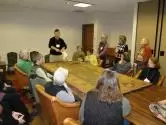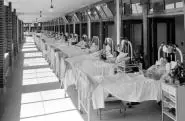Confessions of a Seminar Junkie

After being gone two weeks ago, I stayed pretty close to home these past seven days, catching up on emails, finishing up loose ends from this past February’s National Arts and Crafts Conference, and continuing to make plans for the February 19-21, 2016 conference at the Grove Park Inn.
One of the first items on my agenda is selecting your seven seminar speakers. While doing so eleven months in advance may seem a little eager, I do it for two reasons. First, it enables the seminar speakers to immediately begin thinking about their topic, and how they are going to approach, organize, and present it to you. Second, it enables us to begin publicizing the topics and speakers here and at www.Arts-CraftsConference.com. The sooner we make those announcements, the sooner you can make your decision to book your place both at the Grove Park Inn and the conference itself.
And being something of a seminar junkie, I could not help but make the short drive into Asheville last Thursday night to listen to a seminar being presented by the Asheville Preservation Society. April Birchfield, an instructor at Asheville-Buncombe Technical Community College, presented her most recent research in a slide presentation entitled “Victorian Health and Tourism.”
My motivation to attend was also self-serving, as I am often called upon to speak or write on Asheville’s history, so I am always watching for opportunities to gain additional information and fresh perspectives.
And what I immediately liked about April’s presentation was that she came to the podium to prove a clearly stated thesis: that Asheville is a popular destination today because of its early history as a medical facility for tuberculosis patients.
Now one of my favorite subjects, Edwin Wiley Grove, a prominent Asheville real estate investor and owner of the 1913 Grove Park Inn, led the fight in 1909 against the tuberculosis sanitariums that were springing up around Asheville. At the time Grove moved to Asheville, there were already ten sanitariums just on Sunset Mountain alone, near the future site of the Grove Park Inn. Whenever possible, Grove bought them up and tore them down, inserting stipulations into his real estate contracts forbidding new property owners from erecting sanitariums or boarding houses on any land purchased from Grove.

Ironically, as April Birchfield accurately pointed out, both E. W. Grove and George Vanderbilt, along with scores of other prominent Asheville residents, had themselves first been attracted to Asheville by their need for the medical facilities which had developed out of these early tuberculosis sanitariums.
Grove and others recognized, however, that if a proposed national tuberculosis center were to be built in Asheville, it would kill the city’s fledgling tourism trade, one that the Grove Park Inn and other hotels depended on. Asheville would become, as one civic leader declared, a leper colony for tuberculosis patients.
In the end, as April demonstrated, tourism won out over tuberculosis, as the sanitariums and boarding houses began disappearing. At the close of April’s question and answer session, one woman in the audience spoke up, pointing out that one of the unregulated boarding houses that accepted tuberculosis victims — Julia Wolfe’s “Old Kentucky Home” — did not close in time to prevent two of her children from dying from tuberculosis, including Asheville author Thomas Wolfe, who died tragically at the age of 38.
See why I enjoy seminars so much?
Wednesday: Brown bag lunch seminar at Asheville’s Pack Memorial Library!

Until next Monday,
Seek one out!
Bruce
A Tip for All Speakers: Never put more than one image on the screen at a time. Shrinking or crowding two or three pictures onto one screen only guarantees that the rear half of your audience won’t be able to make out any of the critical details.
Middle: Photo courtesy of www.underworldtales.com.
